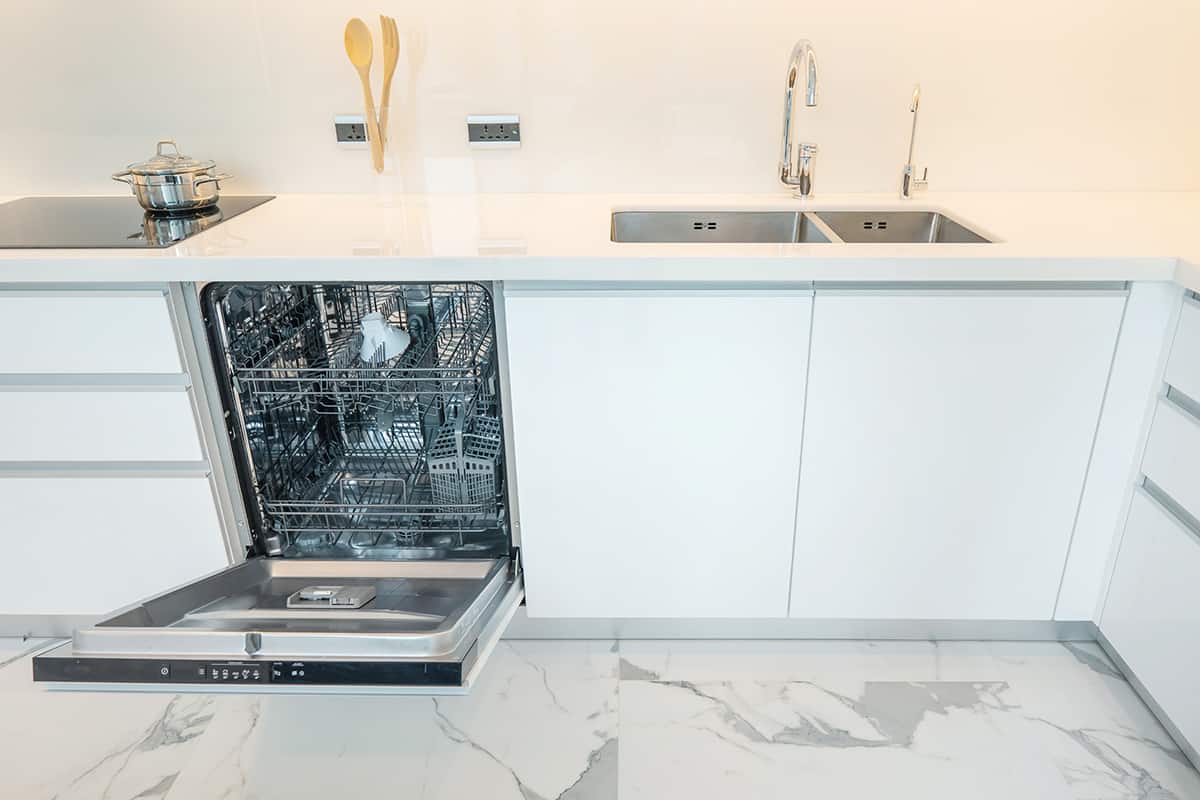A kitchen is a high-traffic part of the house, and as a result, wear and tear virtually is unavoidable. Near the dishwasher, where steam often rises to the counters and cabinets, is one area in the kitchen where there is a greater risk of heat-related damage and even mold problems. How can you avoid this from becoming an issue and causing long-term damage?
There are plenty of ways to prevent your dishwasher from causing damage to your countertop, such as installing adhesive heat shields, choosing a dishwasher that has a gasket, using melamine laminated countertops, installing the dishwasher properly, and venting steam away from your countertop.
So far, I’ve only given you general ideas on how to keep your dishwasher from ruining your countertop, but if you’d like to explore these solutions, I’ll provide in-depth explanations down below.
What Causes a Dishwasher to Vent Steam?
If you have ever had trouble with dishwasher steam venting up to the countertop, then you are not alone. Many people have been struggling with this problem.
The good news is that it is not just about installing your dishwasher in the right manner but also identifying problems with it, if any. Many people have been struggling with dishwasher steam venting up to the countertop.
It can be caused by several factors such as:
- The wrong size of hoses
- Wrong connections of pipes or valves (open or closed)
How to Protect a Countertop from Dishwasher Steam
There are many methods to prevent your dishwasher from causing steam-related damage to your beautiful counters.
But before we explore those solutions, it’s important to go through the various kinds of countertops, as well as dishwasher vents, to have a better picture of the potential harm.
Different Types of Countertops

There is an endless selection of countertops you can install in your kitchen, ranging from laminate to ceramic to stone. Countertops made of granite or quartz are naturally resistant to moisture and steam, and as such, you won’t have to worry as much about your dishwasher causing damage to them.
However, the type you do have to worry about is laminate, which is made from a composite of plastics, particleboards, and even paper. Not to mention the adhesive used to keep the laminate in place could also become affected by excess steam and heightened humidity.
Does that mean that you should swap your laminate countertops for natural stone, which can cost a fortune? Of course, not. There’s a type of laminate that you use can that will not be as affected by steam, which I’ll cover in a bit.
Dishwasher Vent Types
Dishwashers come with vent ports or slits that are in place to remove steam and moisture from the machine. After all, increased humidity inside and around the dishwasher could lead to accelerated rusting, so dishwashers need to remove steam as quickly as possible.
However, the main problem is that steam travels upward, which means that your integrated dishwasher might ruin your countertop and even adjacent cabinets without proper care.
Luckily, there are dishwashers with strategically placed vents, which force steam forward and out of the way. I’ll discuss this type of dishwasher in greater detail later on.
5 Ways to Prevent Dishwasher Steam from Damaging Countertops
1. Install contact paper or heat shields
Contact paper is the most inexpensive tool you can utilize to prevent dishwasher steam from damaging countertops. In addition, they come in a variety of styles and motifs, meaning that you will most likely find one that matches the décor of your kitchen, whether you’re looking for a marbled look or a solid color.
In addition to contact paper, you can place heat shields between your dishwasher and countertop. A heat shield is an adhesive-backed material that insulates heat from steam or flames and prevents them from damaging other appliances, back walls, and other surfaces. You can place a heat shield between the dishwasher and the underside of the counter, but it will do very little to block moisture.
2. Buy a dishwasher with a tub gasket and tight seal
If you have yet to buy a dishwasher but are already worried about how steam can affect your countertop, then you should look for a dishwasher that is specifically designed to avoid this problem entirely. Look for a dishwasher that has a tub gasket and a tight seal around the door. That way, steam has no chance of escaping mid-cycle.
If you’re up for it, consider getting a portable countertop dishwasher. This machine sits on top of the counter, so it poses virtually no risk of causing steam damage to the surface underneath its legs. However, they have smaller tubs and thus limiting washing capacities.
3. Get melamine laminate countertops

If you already have a dishwasher but have yet to choose the type of material for your kitchen counters, then you should choose a countertop that is resistant to heat and steam. You can choose a costly material like granite or quartz, or you can go with a relatively inexpensive laminate known as melamine.
Melamine laminate is made of a synthetic material that adds an additional waterproof layer on top of the particleboard. In addition to resisting heat, it’s glossy surface will repel dirt, water, and other annoyances in the kitchen.
4. Proper dishwasher installation
Believe it or not, the way a dishwasher is installed will also affect the severity of steam-related damage. This is especially true if you get an integrated or under-the-sink dishwasher.
Make sure the machine is not installed too deep inside the cabinet as it can make redirecting steam a challenge. Also, allow for at least half an inch of vertical clearance between the top of the dishwasher and the bottom of the counter to allow steam out toward the front of the cabinet door.
If you have a portable freestanding dishwasher, make sure the back of the machine does not sit flush against the wall. Allow for at least 3 inches of space to let steam vent efficiently.
5. Vent direction
Many modern dishwashers come with front-facing vent ports, which push steam forward and out of the cabinet rather than allowing steam to rise. With proper installation, you can prevent steam damage from occurring with such a dishwasher.
Alternatively, you can install foil vents that redirect steam from the back of the machine toward the cabinet door, though this DIY solution is not always reliable.
How to Install a Dishwasher Vent Kit
Here are the steps you can follow.
- Check that the kit has all the parts for your model of dishwasher.
- Verify that the size of these parts is correct for your dishwasher.
- Check if this is a single or double vent kit, as that will determine how long it needs to be as well as which screws you will need to use (see step 3).
- Unpack your dishwasher and place it in the space where you want to install it.
- Check the location of the dishwasher vents, drain line, electrical connection, and water line to make sure they are available for installation.
- Make sure there is at least a quarter-inch gap between the floor and bottom of your dishwasher when it’s installed upright so that air can flow freely through its venting system during operation (this is known as “clearance”).
- Remove the top access panel of your dishwasher by unscrewing the screws that hold it in place.
- Using a screwdriver, remove all of the screws from around the edge of your dishwasher’s top access panel.
- Take care not to damage or scratch any part of your dishwasher as you’re removing this piece; if you do, make sure to clean off any marks with a soft cloth.
- Use a wrench to remove all the screws that hold the front panel of your dishwasher in place. Be careful not to strip any of these screws, but don’t over-tighten them either.
- If you plan on removing the door from your dishwasher as well as installing a new vent kit, don’t remove any of these screws, or else it will be very hard (or impossible) for you to put everything back together again later on.
- Open up your dishwasher door and pull out on the bottom front panel of your dishwasher until it comes out from its frame. Use a screwdriver or butter knife to pry the bottom front panel away from the frame, and then use a towel to protect your hands as you lift it off. If you don’t have either of these tools, use a small rag folded into quarters instead for extra cushioning.
- Remove both retaining clips that hold in the drain hose of your dishwasher. The retaining clips are located on either side of the drain hose and must be squeezed in order to remove them.
- While you have one hand holding down one of these retaining clips, use a knife or flathead screwdriver to pry up on the other retaining clip until it pops out from underneath its locking tabs. You may need to use pliers or another tool with more leverage to accomplish this step (see picture).
- Once both retainers have been removed, pull gently but firmly on the drain hose until it comes free from where it meets with your dishwasher’s drain line connector (also known as an “S-trap”).
- Wiggle the drain hose out from its frame and move it over so that it’s out of your way for now.
With the drain hose removed, you can now turn your attention to removing the dishwasher from its frame. This process is fairly straightforward and will take less than 20 minutes:
- First, disconnect all power sources from inside the unit. Typically, there will be a power cord connected to an electrical outlet on one side of the unit and another power cord that leads back into a wall socket or breaker box on another side of the unit.
- Next, you’ll need to disconnect any water supply hoses or wiring harnesses that may be plugged into your dishwasher.
- Once everything has been disconnected from inside your dishwasher, grasp both sides at corners near where they meet in front of you (left side up top) and carefully lift it up out of its frame.
- Be sure not to damage anything during this process!
- Place rubber washer seals on both ends of the hose connector that came with your vent kit. Take one end of the hose connector and attach it to the drain line of your dishwasher, then tighten its clamp so that it is secured in place.
- Fit a 90-degree elbow onto each side of the hose connector by attaching one end of each elbow onto each end of the hose connector, then use clamps to secure each elbow in place on opposite ends of the hose connector.
- To connect the dishwasher drain line to your vent pipe, wrap an S-shaped clamp around your dishwasher’s sink drain line and attach it to itself using plumber’s tape or a zip tie (the latter is easier).
- Attach one end of a short piece of pipe to your kitchen’s vent pipe using a 45-degree angle adapter and plumber’s tape or a zip tie. Then tighten it with additional plumber’s tape or another zip tie if necessary so that they’re snug against one another without being too tight—you don’t want them pulling apart when you move something heavy!
Will Steam Damage Kitchen Cabinets?
While steam is a great sanitizing agent, it’s not something that we want to introduce to the surface of laminate countertops if avoidable, let alone wooden cabinets. Moisture can cause the wood to expand, which can give it an unsightly bulge without treatment. In addition, steam can discolor cabinetry over time.
If moisture from steam ever penetrates the surface of wooden or laminate cabinets, the homeowner should act immediately.
First, dry the cabinets as much as possible to prevent the moisture from residing inside the material and expanding in the future. You can do this by placing a pedestal fan in front of the cabinet and letting it run at high speed for 6-12 hours, or you can use a dehumidifier.
When the cabinets are as dry as a bone, apply waterproof treatment to the surface of the adjacent cabinets. There are several waterproof sprays and mats that could come in handy.
Finally, when water or steam ever lands on the surface of your cabinets, make sure to wipe it away immediately. So, whenever the dishwasher has completed a cycle, use a microfiber towel to wipe the surface of the adjacent cabinets. That way, you won’t have to whip out your dehumidifier whenever you run the dishwasher.
How Much Clearance Does a Dishwasher Need to Prevent Steam Damage?
While there are several ways to protect your countertop from dishwasher steam, the best method is to focus on the machine’s placement. This means installing the machine in the ideal spot in your kitchen and with plenty of space around it.
There should be at least 27 inches of free space in front of the dishwasher’s door. That way, front-facing steam vents can force steam forward and away from counters and cabinets without bouncing back. Also, allow for a ½- to 1-inch gap from the top of your dishwasher to the bottom of the counter to allow steam to escape from the back.
When in doubt, consult the owner’s manual to find out where and how to install the dishwasher.






